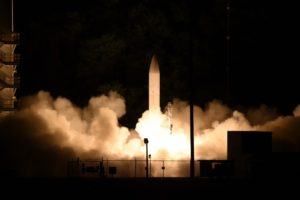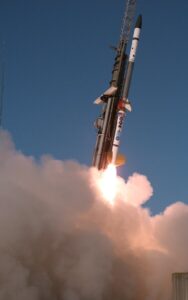A Navy official last week admitted the cost of hypersonic weapon development is too expensive and the existing industrial base is too small for the military services to not work together.
During the Naval Submarine League annual symposium on Nov. 1, Vice Adm. Johnny Wolfe, director of the Navy’s Strategic Systems Program office, said hypersonic weapons are “a game changer that we need,” but said one of the main lessons the Defense Department has
“learned is on these high end systems, it is no longer affordable for a single service to do that. So we’re working with OSD, we’re working with the Army and with what our resource sponsor is doing to figure out how we build this capability once and get it to multiple platforms.”

When asked by reporters on the sidelines of the event what factors drive that need for the services to cooperate, Wolfe said, “it’s a little of everything.”
“Cost is big- if you look at the way we’re doing this program, the Army has had a portion of the cost as we develop this, the Navy has, [the office of the Secretary of Defense] has, as we look at all the technologies that just in what we’re doing in Conventional Prompt Strike might be applicable to other hypersonics programs or even to missile defense for that perspective,” he continued.
Wolf also noted the industrial base for these types of weapons is small and if the services were fighting over the sparse industry, the situation would be worse.
“We’re kind of, in hypersonics, building this industrial base up from the ground. And if we all had individual programs, we’d probably be going to the same folks. We’d be jumping, we’d be pushing on each other to get to the right capacity.”
Instead, Wolfe said having the services share one Common Hypersonic Glide Vehicle (C-HGV) allows them to field the capability they are trying to get in a reasonable timeframe.
The Navy and Army are using the same all-up round with an initial Army deployment set of 2023. The Air Force is set to use the same glide body, but a different launching mechanism. The Army will launch its hypersonic weapons from a traditional truck while the Navy is planning to base the weapons on Zumwalt class destroyers by 2025 and Virginia-class submarine by 2029.
Wolfe also highlighted successes and argued recent failures are not as not as discouraging as they may appear.
Wolfe said the Army and Navy’s Joint Flight Campaign (JFC)-1 test from June had some success even though “we did not fly all the way to target on JFC-1.”
Wolfe said the services proved the glide body and all the boosters with JFC-1 successfully getting the first and second stages to light off correctly, reducing risk in those areas.
However, the test had an integration issue that caused the failure. The upcoming JFC-2 test that will include a payload adapter the Army and Navy expect to improve the process.

He also emphasized JFC-1 was a quick turnaround given the Pentagon only officially decided in 2018 to deploy hypersonic weapons, so some failures along the way are expected.
“If we’re going to go fast, we’re going to have to lean forward and we’re going to have to take risks. We’re going to have to do some things that we have historically would not do as we move forward,” Wolfe said.
“The data that we recorded in so doing that, it allowed us, within seven weeks of that flight, we had identified what the issue was, we had developed a corrective action and it is already in the next round that we’re going to fly as we start to finish up all the integration to get ready for the next flight.”
Wolfe also said “failure, not success, is in the eye of the beholder. It’s all about risk management, and we understood that we were taking a lot of risk in this first test. We understood that, we communicated that all we have to Congress.”
He said Congress was supportive of continued testing after JFC-1 when they were told the results within two weeks of the event.
“They absolutely understood that and unlike other programs, where it’s like, okay, all stop, we got to go spend a year and go figure this out. They kept saying, what do you need, so we could keep moving. That’s what I think is fundamentally different.”
He also spoke to an October 2021 test, called Flight Test-3 (FT-3), which had a booster failure.
Wolfe said FT-3 was not a full system the military would deploy, but they used an old Army booster stack in order to try to get more data more quickly.
“So we had a booster stack that, quite frankly, was an old booster stack that had been sitting around. And so we put a glide body on there to fly. The booster stack is where we had the issue, it had nothing to do with the data that we were really trying to get.”
Wolfe argued the Army still “learned a lot about how we need to integrate on some of these different things. So it was it was a pretty good test.”